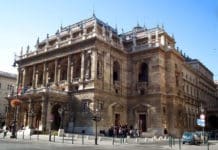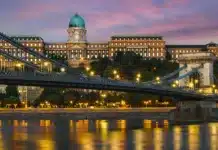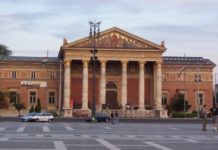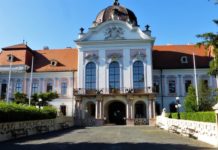Perched majestically on Castle Hill, Budapest’s Matthias Church stands like an architectural jewel, bearing witness to Hungary’s turbulent history. With its impressive Gothic architecture and artistic treasures, Matthias Church is a place of worship and a living symbol of Hungary’s national identity.
With its slender towers and centuries-old stone walls, the Matthias Church in Budapest, also known as The Church of the Assumption of the Buda Castle, is a Gothic marvel that catches the eye of visitors to the Hungarian capital.
The history of Matthias Church in Budapest
The history of Matthias Church dates back to the 13th century, when King Béla IV of Hungary decided to build a church dedicated to the Virgin Mary on Buda Hill. This decision marked the beginning of an ambitious project that was to transform the city’s skyline and influence its destiny for centuries to come.
Construction of the church began in 1255 during the reign of King Béla IV, but it was not until the 14th century that Matthias Church acquired its current form, with its distinctive Gothic features. Over the centuries, the church has undergone several renovations and additions, reflecting the architectural and artistic styles of different eras. However, despite these changes, the Gothic essence of the church has been preserved, adding to its timeless charm.
In the course of its eventful history, Matthias Church has witnessed many major historical events that have shaped the destiny of Hungary. During the Ottoman occupation in the 16th century, the church was converted into a mosque, suffering considerable damage. However, after the liberation of Buda in 1686, the church was restored to its original function, once again becoming a place of Christian worship.
One of the most remarkable periods in the history of Matthias Church was undoubtedly the reign of King Matthias Corvinus in the 15th century. Matthias, renowned for his love of art and culture, helped to embellish the church with exceptional works of art, including the famous altarpiece by Albrecht Dürer, which remains one of the highlights of the church’s collection.
Matthias Church and its unique architecture

The exterior architecture is a harmonious blend of Gothic and Neo-Gothic styles. The main façade of Matthias Church is adorned with spectacular architectural details, highlighting the expertise of the craftsmen who built it. Traditional Gothic elements, such as slender buttresses, pointed pinnacles and carved rosettes, give the church an elegant and imposing appearance. The façade is also adorned with religious sculptures depicting biblical stories and holy events.
One of the most striking features of Matthias Church is its colourful roof, decorated with glazed ceramic tiles. These tiles are decorated with intricate geometric patterns and floral motifs, creating a dazzling visual spectacle that stands out among the surrounding buildings. The roof of Matthias Church is often compared to a Persian carpet because of its rich detail and artistic beauty.
The twin towers rise proudly into the sky some 80 metres above the ground, offering breathtaking panoramic views of the city and the Danube. It is possible to climb to the top of one of these towers (197 steps), which offers visitors a unique perspective on the beauty of Budapest.
An interior not to be missed, with its artistic and cultural treasures

As soon as you walk through the doors of the church, you are immediately struck by the grandeur of its interior. The high vaulted ceilings seem to reach for the sky, creating a feeling of space and solemnity. The walls are astonishingly decorated with ancient frescoes and religious paintings depicting biblical stories and holy events.
The interior architecture of Matthias Church is a harmonious blend of Gothic and Neo-Gothic styles, with slender columns, pointed arches and colourful stained glass windows that filter the sunlight and bathe the space in a warm, celestial atmosphere.
The church’s altars are masterpieces of sacred craftsmanship. Richly adorned with hand-carved wooden sculptures and gilded decorations, these altars are the focal point of devotion for the faithful.
The church’s side chapels are also home to artistic and religious treasures. Marble sculptures, bas-reliefs and decorative stained glass windows add a touch of splendour to these intimate spaces, offering visitors a glimpse of Budapest’s cultural and spiritual wealth.
Finally, the Matthias Church organ is another remarkable feature of its interior. Renowned for its exceptional sound quality and visual beauty, this impressive instrument fills the space with sacred music during church services and concerts.
As you explore the interior of the church, you will also discover hidden treasures and sacred relics. Secret chapels, crypts and side altars house ancient icons, relics of saints and other precious religious artefacts that tell the story of faith and devotion through the ages.
Legends and myths about Matthias Church in Budapest
A famous legend associated with Matthias Church is that of the mystical raven. According to legend, during the construction of the church in the 13th century, a raven brought a precious ring to a worker on the building site. This ring was stolen by a raven from the Prince of Buda, and its discovery by the worker was interpreted as a divine sign of protection for the church under construction. Since then, the raven has become a symbol of luck and blessing for Matthias Church.
Another popular legend is that of eternal love. According to this story, King Matthias Corvin of Hungary married the beautiful Beatrice, whose beauty was legendary throughout Europe. Their wedding was celebrated in Matthias’ church, and it is said that the king promised Beatrice to build her a palace more beautiful than that of the kings of France. Today, the royal palace in Buda, located near the church, is seen as a tribute to this eternal love.
Certain legends are also linked to the church’s hidden treasures. It is said that the walls of the church contain priceless treasures, including sacred relics, gold coins and precious jewels. Stories of Templars, knights and mystical quests surround these hidden treasures, adding a touch of adventure and mystery to the history of the church!
Discover the Matthias Church in this superb video filmed by drone:
Concerts at the Matthias Church in Budapest
Matthias Church hosts a classical music concert every week. You can choose from 3 different seating categories, depending on your preferences and budget, and listen to the Duna String Orchestra and soloist Gabora Gyula on violin. Concert every Friday at 7pm:
Matthias Church Concert information and tickets – click here
How to get to Matthias Church:
By bus:
Take bus 16/16A from Szell Kalman Square (on metro line M2) or bus 16 from Deak Ferenc Ter Square (on metro lines M1, M2 or M3).
By funicular :
You can take the Buda Castle funicular from Clark Adam Square, at the foot of the Chain Bridge, up to Castle Hill. From the funicular terminal, it’s about a 5-minute walk to Matthias Church.
Matthias Church Opening hours:
Open Monday to Friday from 09:00 to 18:00.
Saturday from 09:00 to 12:00.
Sunday from 13:00 to 17:00.
Matthias Church Admission tickets:
You can purchase your church entrance tickets in advance from this link.
There is a different entrance ticket for access to the tower (on this link) which can only be climbed via a narrow staircase of 197 steps to access a beautiful panoramic view of Pest and the roof tiles of Matthias Church.
Address: Matthias Church, Szentháromság tér 2, 1st district, Buda – map – website.


















